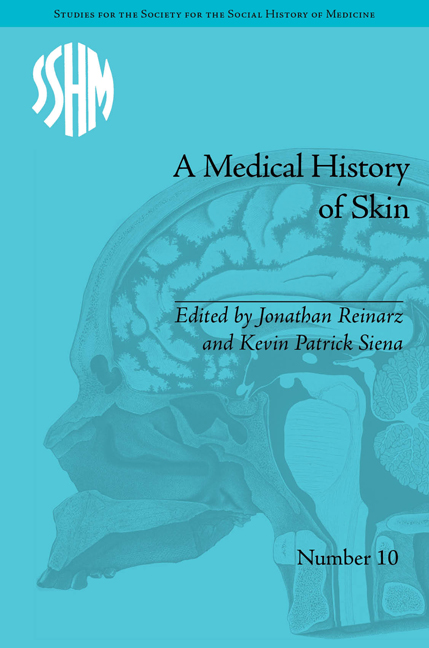Book contents
- Frontmatter
- CONTENTS
- List of Contributors
- List of Figures and Tables
- Scratching the Surface: An Introduction
- Part I The Emerging Skin Field
- 1 Drain, Blister, Bleed: Surgeons Open and Close the Skin in Georgian London
- 2 Abominable Ulcers, Open Pores and a New Tissue: Transforming the Skin in the Norwegian Countryside, 1750–1850
- 3 Protecting the Skin of the British Empire: St Paul's Bay Disease in Quebec
- 4 ‘Italic Scurvy’, ‘Pellarina’, ‘Pellagra’: Medical Reactions to a New Disease in Italy, 1770–1815
- Part II Skin, Stigma and Identity
- Part III Skin, Disease and Visual Culture
- Afterword: Reading the Skin, Discerning the Landscape: A Geo-historical Perspective of our Human Surface
- Notes
- Index
1 - Drain, Blister, Bleed: Surgeons Open and Close the Skin in Georgian London
from Part I - The Emerging Skin Field
- Frontmatter
- CONTENTS
- List of Contributors
- List of Figures and Tables
- Scratching the Surface: An Introduction
- Part I The Emerging Skin Field
- 1 Drain, Blister, Bleed: Surgeons Open and Close the Skin in Georgian London
- 2 Abominable Ulcers, Open Pores and a New Tissue: Transforming the Skin in the Norwegian Countryside, 1750–1850
- 3 Protecting the Skin of the British Empire: St Paul's Bay Disease in Quebec
- 4 ‘Italic Scurvy’, ‘Pellarina’, ‘Pellagra’: Medical Reactions to a New Disease in Italy, 1770–1815
- Part II Skin, Stigma and Identity
- Part III Skin, Disease and Visual Culture
- Afterword: Reading the Skin, Discerning the Landscape: A Geo-historical Perspective of our Human Surface
- Notes
- Index
Summary
… are your olfactory nerves so delicate, that you cannot avoid turning sick when dressing an old neglected ulcer? or, when, in removing dressings, your nose is assailed with the effluvia from a carious bone? If you cannot bear these things, put surgery out of your head, and go and be apprentice to a man milliner, or perfumer.
From Mr Peters, a surgeon:
[On] Dec. 28. 1737. James Channon, aged about 14, was accidentally shot in his Back by another Lad at the Distance of Two Yards from him; so that the whole Load of [Gun]Shot, not having Space to scatter, enter'd like a Ball, by the Edge of the Left Scapula, which it splinter'd … [it then] pass'd between the two superior Ribs, and fractur'd the Clavicle – with a Touch of the Incision-Knife … I took out about a dozen shot.
Mr Peters then bled James and bandaged the wound on his back. A week later, he expressed satisfaction at the development of ‘healthy suppuration’. But then the suppurating pus became so copious that ‘When the dressings were removed, I frequently made him force a Cough, and try if he could not throw out any Pus by his Mouth; but, instead of passing that Way, it flew out thro’ the Wound like Water from a Pump … and the “Air which was forc'd thro” the Wound by Coughing, would blow out a Candle, which I often experienced – I thought he would die’.
- Type
- Chapter
- Information
- A Medical History of SkinScratching the Surface, pp. 17 - 30Publisher: Pickering & ChattoFirst published in: 2014



